#just as the continuity headaches with wonder woman and donna troy
Explore tagged Tumblr posts
Text
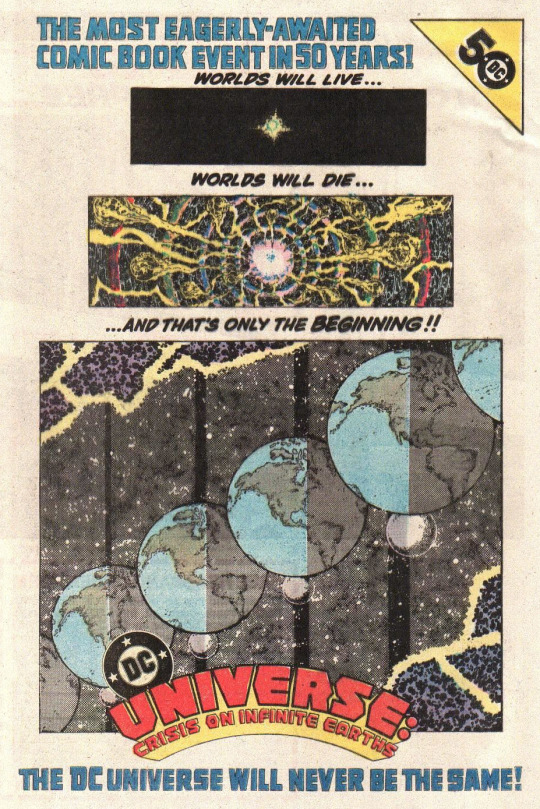
March 1985. Whatever else one may say about the Crisis on Infinite Earths, it was a triumph for truth in advertising: Worlds lived, worlds died, and the DC Universe was never the same. A cynic might add, "And nothing ever made sense again," since the event kicked off almost 40 years of retcons, revisions, and successive reboots, which DC used to internally describe as "white events," after the cataclysmic moment in CRISIS ON INFINITE EARTHS #10 where the original multiverse was shattered and recreated:

Even before the Crisis event was ever conceived, DC had a long history of fairly dramatic editorial and creative shifts, some of which hung on specific story events (like the de-powering of Wonder Woman in 1968) and some of which did not (like the inauguration of Batman's "New Look" in 1964). With the benefit of hindsight, it's possible to make some general observations about editorial revisionism and efforts to tear down and rebuild internal continuity:
It's ultimately easier (and more effective) to ignore than to change. When Julius Schwartz became Batman editor in 1964, he dispensed with many characters and concepts that had been staples under his predecessor, Jack Schiff, such as Batwoman and Bat-Mite. With one exception, there was no story explanation of where they'd gone — they just stopped showing up and were soon forgotten. The exception was Alfred the butler, who was killed off dramatically in DETECTIVE COMICS #328. When the producers of the 1966 Batman TV show decided to incorporate Alfred into that series, Schwartz was obliged to resurrect him, in a singularly preposterous way, after which he was regarded as indispensable. By contrast, while most of the characters who'd simply been ignored also returned, it was much later and generally in quite minor ways; their long absence reduced them to marginalia that could be incorporated or not, as seemed most useful.
Crossovers are the most serious and persistent enemy of change. The nature of company-owned comics is that the characters will inevitably show up in crossovers, team-ups, and events of various kinds, often written, drawn, and edited by people who aren't familiar with the finer points of the characters' history, inevitably resulting in troublesome contradictions, up to and including characters who were previously supposed to be dead inexplicably popping up alive. The more convoluted a change to a character or their history, the more likely that it will misrepresented, accidentally undone, or just ignored the next time the character shows up in a series other than their own.
A true line-wide reboot is commercially infeasible. A publisher like DC or Marvel has many different titles at once, and at any given time, some of them are selling better than others. If a title isn't selling well, there may be nothing to lose by rebooting it or making drastic changes to its characters and direction, but doing that to a series that's currently a hot seller is foolhardy. So, the bestsellers will generally stroll through a "white event" with only minor cosmetic adjustments, while weaker titles may undergo a whole series of radical reinventions. If the former bestseller goes into a slump and one of those radical reinventions transforms an underdog into a hit, the situation will be reversed. Surely this won't backfire later …
Timing is everything. A lot of the confusion that resulted at DC in the wake of the Crisis stemmed from the fact that different revisions happened at different times. For instance, the headaches surrounding Hawkman began in large part because of the editorial decision in 1990 not to treat the Tim Truman HAWKWORLD series as a kind of "Hawkman: Year One" (which is how it was conceived), but rather as a reboot, even though that threatened to retroactively remove the Hawks from books like JUSTICE LEAGUE, which had become very popular following its most recent revamp. This kind of thing creates situations where creative teams have to come up with desperate contrivances to explain retroactive changes to very recent stories. Having Hawkman and Hawkwoman stop showing for Justice League adventures for a while wouldn't have been a big deal, but trying to assert that the Hawkman and Hawkwoman who'd previously appeared were either never really there or were actually somebody else was another matter, and the problems this created were never fully resolved.
Continuity-tidying for its own sake is almost always a creative dead end. This is a lesson that Nelson Bridwell and Roy Thomas demonstrated over and over throughout the Bronze Age: It's one thing to have some flashbacks, if it serves the story, or maybe to retell a character's origin with a few nips and tucks, but if your main purpose is to explain, e.g., why Namor once wore the wrong shorts, the results are likely to be either silly or tedious. This hasn't stopped DC and Marvel from wasting a lot of ink and paper on specials and miniseries that exist to retell earlier stories in an updated, continuity-compliant manner, usually to no good end. The fundamental problem with such things is that their main object is to regurgitate familiar older stories (if they weren't familiar, there would be no point in retelling them) while urging readers who have read the original version (who are the most likely audience) to ignore their lying eyes. This is, with very, very few exceptions, a dismal exercise that routinely defeats even usually reliable creators like John Ostrander (see for example the tiresome 2001–2002 JLA: INCARNATIONS), and frequently results in yet more contradictions to explain or ignore.
The bottom line is that while you can blow things up all you want, the likelihood that they can be reassembled in a clearer, more cohesive way is really quite low, and diminishes the more frequently you try.
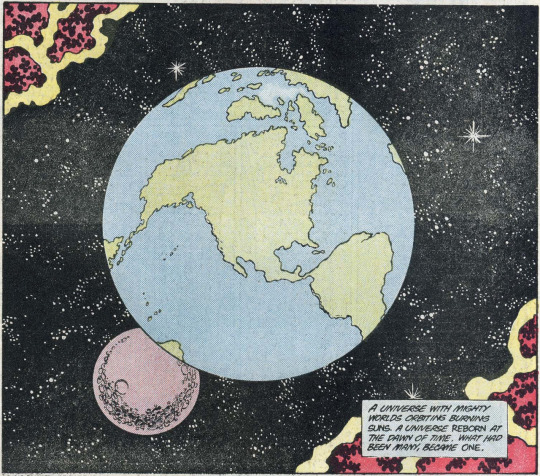
I want to be clear here that this isn't a criticism of the CRISIS ON INFINITE EARTHS series (which has many virtues, along with some significant flaws), or even any of the individual revisions and retcons that have followed, some of which are, in their own right, perfectly fine. The dilemma is that the project that an event like this represents is ultimately a doomed one. It might spark some commercial interest, at least briefly (which is of course at least half the point), but simplification and unity are just not in the cards and probably never will be.
#comics#crisis on infinite earths#marv wolfman#george pérez#jerry ordway#retcons#retroactive continuity#hawkworld (both the truman mini and the ostrander ongoing)#is actually quite good and its troublesome continuity impact#would have been almost entirely avoidable#just as the continuity headaches with wonder woman and donna troy#could have been avoided by treating the first year of the relaunched wonder woman series#as taking place “a few years ago”
23 notes
·
View notes
Text
The History of Wonder Woman
Hey kid, wanna know the history of Wonder Woman? The whole messy lot of it, not just the very start?
Wanna know HOW her books ended up the biggest mess in the entire comics industry? Big clues as to why her movie took so long to make?
It has feminism, racism, sexism, blasphemy, infanticide, and bees...
Wonder Woman was created by Dr. William Moulton Marston, noted psychologist, inventor of the lie detector, writer, and feminist. He secretly lived in a polyamorous relationship with two women who helped him come up with Wonder Woman: his wife, Elizabeth Marston, and Olive Byrne, daughter of the major women’s rights crusader Ethel Byrne (known for helping her sister, Margaret Sanger, to create Planned Parenthood). He was heavily influenced by early-twentieth-century suffragists, birth-control advocates, and feminists.
Even putting aside how jaw-droppingly progressive his woman superhero was, the comics still stand out for how whimsical they were. Wonder Woman/Diana had an invisible plane and a telepathic radio. She jousted on a giant battle-kangaroo, and, like all Amazons, enjoyed deflecting bullets with her bracelets. She fought Nazis, mad scientists, valkyries, mole-men, tiger-ape hybrids, flying mer-sharks, a subatomic army, and her arch-enemy: Mars, the god of war. She regularly battled aliens well before it became common for her peers (including Superman, who in those days was usually taking on gangsters and corrupt politicians). When not kicking back with her mother and sister Amazons she hung out with a short and stout firecracker of a girl called Etta Candy, a slew of college girls, and an Air Force pilot named Steve Trevor that was as disaster-prone as Lois Lane. And while later writers said that gods gave her superpowers under Marston everything she could do was just from training real hard.
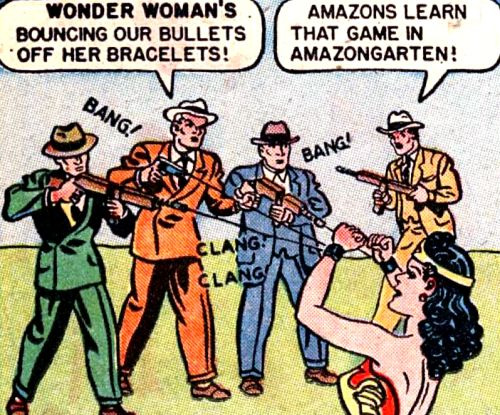
Analysis often puts attention on some elements that are – let’s not beat around the bush – kinky as hell (like the “bondage” aspect of Wonder Woman typing people up and getting tied up), but just focusing on that is a massive disservice to Marston. Early Wonder Woman comics were far ahead of the curve in sheer quirkiness and how progressive they were in their depiction of women (even stating there would be a woman President one day). It certainly helped that s Marston was often helped by his assistant, 19-year old Joye Hummel (I’ll come back to her in a moment), particularly when his health began deteriorating.
Marston put thought into Wonder Woman’s origin. Diana was created when the Amazon Queen, Hippolyta, wanted a child and Aphrodite granted her wish by bringing a clay baby to life. The “artificial woman” is a common theme in religion and mythology, including the most famous examples of Pygmalion and Pandora. Pygmalion was essentially a living gift to a sculptor that the gods liked, while Pandora was clay brought to life by the gods that promptly unleashed all the evil in the world (much like Eve, created from Adam’s rib). Marston could have made Wonder Woman’s father a god (a dime-a-dozen origin for heroes), but instead made her into an inversion of the “artificial woman” trope. Here was a woman made from clay, but she was neither a blight nor a prize to be won; raised by women, she was a hero in her own right. After millennia of blame for all the world’s woes, Pandora got her revenge: Wonder Woman.
How Marston got into comics is a story by itself. At the time, there was a fledgling movement to censor comics (“Dick Tracy is too violent!”). Family Circle magazine published an interview with Marston on the subject, since he was a noted psychologist who had worked for Hollywood as a consultant (the interviewer was actually Olive Byrne, who lived with the Marstons by then and wrote under a pen name). Marston’s defense of comics attracted the attention of DC Comics, who offered Marston a job as an “educational consultant” (wanting to tell any would-be censors that the staff psychologist okayed everything). Marston had offered the opinion that what comics needed wasn’t to censor “violent” heroes but rather to offer nonviolent alternatives, and saw an opportunity to introduce that, as well as to create a prominent female hero. His pitch was a hit - in 1941 Wonder Woman appeared.
Wonder Woman’s use of a lasso tying people up (and getting tied up) certainly boosted sales by appealing to readers that liked seeing a little bondage (including Marston himself). For Wonder Woman to succeed (and for his feminist message to reach male readers), Marston didn’t shy away from titillation. But her heavy use of a lasso wasn’t just a way to attract readers. The frequent imagery of Wonder Woman escaping from ropes and chains provided a powerful image of women escaping their metaphorical bonds. Moreover, it also stemmed from Marston’s desire to offer a less violent hero – Diana lassoed bad guys and explained what they’d done wrong instead of breaking their jaws like Batman or Dick Tracy. Wonder Woman’s compassion was front and center in Marston’s comic, and her efforts to reform her foes were a major theme.
And she certainly had her fair share of foes! Marston came up with a colorful gallery of recurring villains, including Giganta (a gorilla-turned-into-a-woman), Cheetah (think a Kardashian that went crazy and started wearing animal skins while committing crimes), the fascist mad scientist Dr. Poison, the misogynistic mentalist Dr. Psycho, and plenty more.

Marston worked from 1941 to 1947, when he passed away of cancer. Joye Hummel, his assistant, asked to continue writing the book, making an argument like “you know I was writing a bunch of the stories already, right? Marston had polio and cancer; I was doing most of the work near the end.” DC heard her excellent argument and ignored her, giving the book to Robert Kanigher, the book’s editor (making him essentially his own boss), and there’s never been a more disastrous baton-passing between writers in all of comics history.
Kanigher’s Wonder Woman ran from 1948 to 1968. He had co-created The Flash and many other characters, and churned out scripts by the bucketloads, with particular impact on superhero and war comics (including that one with a real-life Confederate general as the hero). But his 20+-year(!) run on Wonder Woman was an unmitigated catastrophe.
The feminist underpinnings of the book were discarded (most egregiously, a section Marston had included in every issue celebrating great women in history was replaced with a section about weddings), and Diana seemed obsessed with Steve Trevor. As Dr. Fredric Wertham led a high-profile moral crusade against comics, DC kept Wonder Woman as inoffensive to 50s sensibilities as possible. Stories pitted her against monsters, mobsters, and aliens (with the occasional story about strange creatures falling in love with her), and while parts campily echoed Marston’s absurdist moments (Dinosaurs in a Department Store!), the core of the book withered. Steve became an “alpha-male” that felt threatened by Wonder Woman’s heroics… and she felt bad about it. While Steve and Hippolyta still showed up, the rest of the supporting cast were forgotten and nobody took their place. The idea that her feats stemmed from Amazon training was dropped – Wonder Woman was given superpowers by the gods (including flight, rendering her invisible plane obsolete).
Kanigher’s frequent time-traveling stories let Wonder Woman team up with her younger self. Thus, for a much of a 20+-year period, rather than building up a solid cast, Wonder Woman was left literally talking to herself. When Robin brought together other sidekicks to create the “Teen Titans,” nobody involved was paying enough attention to realize Kanigher’s "Wonder Girl” was just a younger Wonder Woman. After spotting the error, DC said the Wonder Girl in Teen Titans was a new character (“Donna Troy”), but attempts to retroactively connect her to Wonder Woman underwent so many rewrites over the years that she remains one of the biggest headaches in comics. When people read Teen Titans, they learn that Wonder Woman’s book is confusing.
Despite being on the book for over 20 years, Kanigher’s only notable new characters were Angle Man (a generic recurring mobster), Egg Fu (an evil egg/racist Chinese caricature, see below), Nubia (“what if we made another Wonder Woman, only this time with black clay?”), and Circe (another character plucked from mythology). Of the recurring villains that Marston had created, Kanigher used Dr. Psycho a few times, Cheetah twice, Giganta twice, and… that was about it. At a time when heroes like Batman, Superman, and The Flash were building up villains, settings, and supporting casts, Wonder Woman’s world was shrinking as fast as her peers’ were growing.
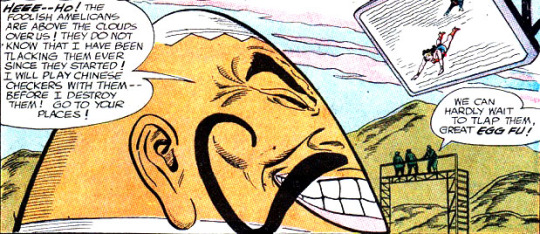
When his run concluded, Kanigher had essentially left Wonder Woman with no notable villains and a supporting cast smaller than when he had inherited the book 20 years earlier. Worse, book’s feminist soul was in tatters. The book was handed off to Denny O’Neil in 1968.
O’Neil, a major Batman writer, was almost as mismatched for Wonder Woman as Kanigher, and his editor wanted drastic changes to improve sales. O’Neil killed Steve (a mercy at that point), depowered Wonder Woman, and gave her an elderly Asian martial-arts instructor – basically trying to turn her into a spy-themed 70s movie hero.
Thankfully that run only lasted only a few years, and from 1974 to 1986 the book was thrown like a hot potato from writer to writer. Nobody stayed, little was built, Steve was brought back to life, Steve was killed again, Steve came back again, the setting was shifted to World War II (because the hot new TV Show was set in WWII), and then back to present day… it was clearly a book in serious trouble.
When Superfriends (the first Justice League cartoon) debuted in 1973, there was no clear major Wonder Woman villain in the books, so the show settled on Cheetah (who had racked up a paltry 9 appearances, including a reprint, in the 30 years that Wonder Woman had been around).
And when Lynda Carter’s Wonder Woman live action TV show came out in 1975, it was a hit that cemented the character’s prominence in American pop culture, but it was set in World War II. Wonder Woman wasn’t the only hero to be created in WWII, but hers was the only comic with its glory days so clearly in the past.
In 1986, DC rebooted their entire line of comics, wanting to start from scratch, updating and streamlining the best of what came before. Wonder Woman was given to George Perez (and Len Wein), and his brilliant run took the most iconic and well-known elements of the character, making it all work. He brought back Etta Candy and made Steve Trevor into a likable human being. The Amazons were fleshed out and given flaws and foibles. He plucked villains from the book’s distant past (Cheetah and Dr. Psycho, now revamped to be foes worthy of a Superman-level hero), and retooled a few of the more recent ones that had potential, like Circe. He showed that at least some Amazons were gay (in 1986!), and found a way to visually combine the classic Wonder Woman costume with more accurate Grecoroman soldier styles. If you’ve ever seen Wonder Woman dressed like a “warrior,” you have Perez to thank.
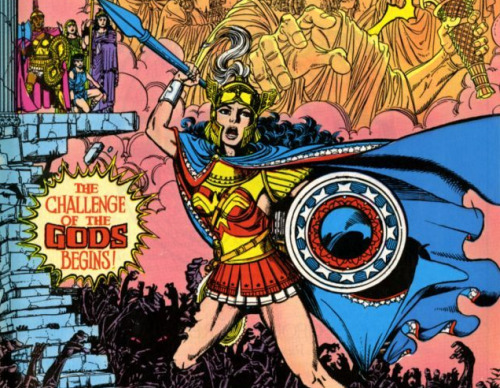
And while Wonder Woman remained compassionate, Perez showed that when there were no other options his Amazon warrior was willing to use lethal force.

Hippolyta and the Amazons were reimagined with a greater emphasis on actual Greek mythology, but at the same time were presented as a mutiracial tribe (of particular note, Perez introduced the black Amazon general Phillipus, who would be presented as Diana’s teacher and Hippolyta’s closest friend).

The difference between them and Amazons of myth was explained as being due lies told to make Hercules look good – in DC’s world the famous Greek demigod had actually deceived, raped, and enslaved the Amazons before they overthrew him and withdrew from the mortal world. In the “starting from scratch” new universe, Diana was written as having just left the Amazon island of Themyscira for the first time, finding a new home in Boston with Julia Kapatelis, Curator of the Museum of Cultural Antiquities (a great friend for an “ancient Greek” suddenly finding herself in the modern world!). Vanessa’s teenage daughter went on a few Wonder Woman-related adventures, and it looked like she was going to become a new (and less confusing) “Wonder Girl”. And Perez brought back the god of war (calling him Ares instead of Mars), who had been virtually absent since Marston’s run. That last bit’s incredible when you consider the villain was clearly her arch-enemy in the early days… imagine if Joker or Lex Luthor had been missing for decades. He also sought to end the cycle of writers not knowing what to do with Steve Trevor – Steve and Etta got engaged.
Then the book was handed to William Messner-Loebs (WML), who wrote it from 1992-1995. Sadly, it squandered almost everything Perez had done. Right at the start it threw her in space, abandoning the cast that Perez had introduced, and when she returned the Kapetalis family was nowhere to be seen. Perez had left one instruction when he left the book – Steve and Etta were to get married. WML had Etta appear a few times (long enough to make the always-comfortable-about-her-weight character bulimic), then wrote her and Steve out of the book without ever showing their wedding (a broken promise that resulted in Perez being furious with DC comics for years).
The Amazons of Themyscira were dropped into another dimension for years (and for most of that time the readers were led to believe Themyscira had been destroyed, so the reveal that it was in another dimension may have been a panic-driven last-minute change). A series of stories showed Wonder Woman trying to have a “normal” life, like holding a minimum wage job at a Taco Bell knockoff (bear in mind she had no secret identity – everyone knew she was Wonder Woman). Notably, he created a gritty new Amazon named Artemis that briefly became Wonder Woman, died, and came back because Wonder Woman desperately needed supporting cast members. Although he added little that was truly bad, WML had cost the book all the momentum and stability that Perez had given it.
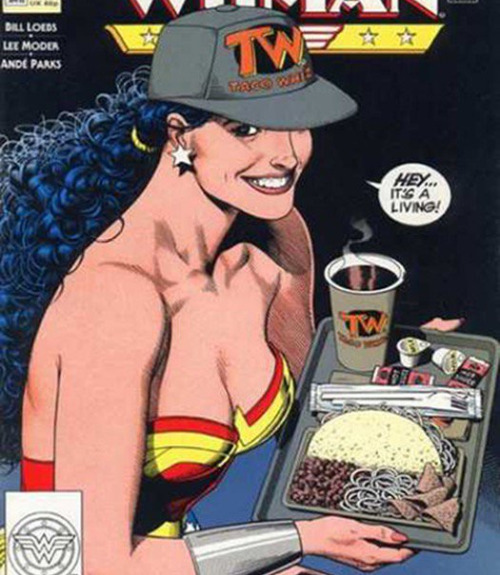
He came up with a gritty new Amazon warrior called Artemis that briefly became Wonder Woman, died, and came back because Wonder Woman desperately needed supporting cast members. Although he ADDED little that was truly bad, WML had cost the book all the momentum and stability that Perez had given it.
John Byrne took over from 1995-1998, and set the tone by slaughtering half the Amazons at the start. His run had little good in it, but wouldn’t be too bad if not for a few things. First, he made a more confusing mess out of Donna Troy (the Teen Titans’ Wonder Girl). Second, he tried to make a flawed hero out of Hercules (established as a rapist in the Perez run). Third, he felt that since the Wonder Woman TV show had been set in World War II there needed to be a Wonder Woman in WWII, even though we’d already seen that the “start from scratch” Wonder Woman’s first adventures were in the modern days. Byrne had Hippolyta, Wonder Woman’s mother, go back in time to become the Wonder Woman of WWII, making her the first Wonder Woman and Diana the second, and if you think that seems really unnecessary then I hope you can go back in time to tell Byrne not to do it. Lastly, he shoved Steve, Etta, and the Kapetalis family even more firmly out of the book by having Diana move (to “Gateway City”), and came up with a “Wonder Girl” that was the teenage daughter of a museum curator specializing in Greek antiquities. Since she was a blatant photocopy of the character that Perez had created to become Wonder Girl, it’s unclear why he didn’t just use Perez’s character (the pattern of Diana’s supporting cast failing to get traction has never stopped).
The book was given to Eric Luke from 1998 to 2000. I’m not 100% certain why he got the axe mid-story, but I can guess - Wonder Woman met Rama, a major Hindu god (who was wearing a leather Korn jacket… a no-no for a Hindu god). They teamed up to fight the Greek god Chronos, who had already defeated the Greek and Hindu Pantheons and was waging war on Christian heaven. Furthermore, there were hints at romance between him and Wonder Woman, even though Rama is married in Hinduism. Perhaps someone in authority felt that the book had wandered into a religious minefield.

Phil Jimenez’s run lasted from 2001 to 2003. He liked the idea of Wonder Woman being the UN Ambassador representing the Amazons and tried to do something with that (for the first time since Perez), and fleshed out the Amazons by showing some of the conflicts between different groups. He implied that Phillipus (Wonder Woman’s Amazon mentor) was in love with Wonder Woman’s mom. He made an effort to draw from all eras of the book’s past (even Kanigher’s – the generic mobster “Angle Man” became a surprisingly enjoyable thief armed with a device that could turn his surroundings into an M.C. Escher drawing). The Kapatelis family from Perez’s run returned. Jimenez’s major new addition to the cast was a new boyfriend by the name of Trevor Barnes, who was killed by a fill-in writer the minute Jimenez left the book (Wonder Woman is not allowed have a consistent supporting cast). And due to the U.N. elements, Diana moved to D.C. (she’s not allowed get a consistent city either). He certainly made missteps - such as replacing Wonder Woman’s best-known original foe, The Cheetah, with a male character by the same name, so for a while this was a thing...

And for some reason Jimenez made a point of bringing up that Wonder Woman was a virgin. But overall, his run stands out for its sustained effort to build up Wonder Woman’s cast and villains, bringing back old favorites from all eras of the book.
Greg Rucka tried to build on the Perez-Jimenez idea of Wonder Woman as an Ambassador from Themyscira. She got an embassy staff as a supporting cast (complete with a Minotaur chef), and the embassy was given a teleportation portal to Themyscira, making it easier than ever to juggle the Amazon and non-Amazon parts of Wonder Woman’s world. Classic villains like Dr. Psycho and Cheetah (female) showed up, along with modernized takes of figures from Greek mythology. It was getting rave critical reviews and had stabilized many elements of her world, but DC decided they had an idea that would boost sales even more (spoiler: they were wrong) so they pulled the plug. The Amazons were yanked into an alternate dimension in a big crossover event and the embassy closed. Diana lost her supporting cast. Again.
DC’s big idea was a major overhaul by TV writer Allan Heinberg… whose run had so many delays that it started in 2006, ended in 2008, and was just five issues long. While Jimenez and Rucka had started to give Diana back stability in her supporting cast and made an effort to dust off and properly revamp some of her enemies, Heinberg went in the opposite direction, throwing villains at her without explanation for who they were, and giving Wonder Woman a whole new cast and a secret identity… as a superspy, drawing on O’Neil’s comics of the 70s of all things. Bear in mind that Wonder Woman had never had a secret identity after her 1986 reboot. Also keep in mind that having a superhero’s secret identity be an adventurous government agent with high-tech gear gets redundant fast. Although Heinberg’s run was a mess and he basically decided that as a TV writer he didn’t need to hand in comic scripts, it’s worth nothing that he has the sole screenplay credit for the new movie. Clearly, he did have a blockbuster Wonder Woman story in him – it just took a while to get it out.
The book was handed to Jodi Picoult, an acclaimed novelist that had never written comics before. It was the first time a woman was (openly) assigned a lengthy stint on Wonder Woman. But rather than let her learn the ropes and give her a chance to show her own vision of Wonder Woman, DC started a multi-title crossover event headed someone else. The event was called “Amazons Attack,” and Picoult was left to follow the lead of Will Pfeifer, a man who had never written Wonder Woman before, and whose knowledge of the character was apparently nonexistent.
The Amazons returned, but Diana wasn’t given a chance to enjoy having her cast back, because they immediately started a nonsensical war. It featured misandrist Amazons that killed defenseless children in cold blood for being male, plot-holes you could drive a truck through, the Amazons trusting Circe (think “Commissioner Gordon agreeing to make The Joker his deputy”), Batman being the one to (easily) defeat Circe, a wtf twist ending that told readers to pick up a non-Wonder Woman book, all leading up to the Amazons being taken out of Wonder Woman’s cast yet again – this time giving them amnesia and spreading them across the world where Diana could never find them (and in another book Pfeifer turned Angle Man from a likable rogue with interesting powers to a pathetic depowered misogynist – a good example of how Wonder Woman’s villains can’t catch a break either). It literally lost track of where characters were and what they were doing from one issue to the next, lost track of characters’ motivations in the story, contradicted itself on what characters could do, and tarnished Wonder Woman’s cast like nothing written before. Amazons Attack was DC’s first (and to-date only) big multi-book event revolving around Wonder Woman, and it’s best remembered for being awful. And for this:
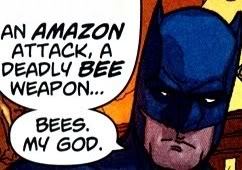
After being forced to work on that, Piccoult walked away from DC and likely comics as a whole (she’d been greeted by the very worst that the industry has to offer). The book was given to Gail Simone, whose run lasted from 2007 to 2010. She made an attempt to use the spy agency supporting cast left by Heinberg. While the book was often plagued by writers not using the supporting cast left by the previous writer, Simone may have been the only writer who probably should have dropped what she’d been left. The pseudo-Agent of SHIELD secret identity failed to gel, even when Simone brought back Etta Candy. Unfortunately, Etta was one of very few things that Simone brought back – her run made heavy use of characters from other books, including characters from Flash, Green Lantern, and an obscure sword & sorcery book from 1975. Wonder Woman’s own supporting cast and villains remained in terrible shape. Simone started finding her footing (bringing back the Amazons and setting the stage for a wedding between two of them – Hippolyta and Phillipus, Wonder Woman’s mother and mentor!) when she was taken off the book in favor of another famous TV writer with his own vision.
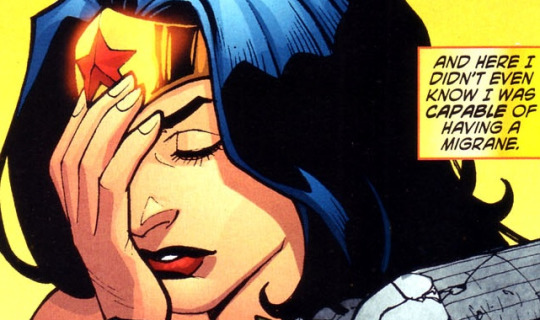
J. Michael Straczynski rebooted Wonder Woman in an alternate reality where things had happened very differently (for one thing, Wonder Woman wore pants!), the Amazons were all but extinct, and there were a couple interesting things in his run aaaand The End. Less than a year in, DC reassigned him to things they thought would be more profitable.
The book was turned over to hardboiled crime series writer Brian Azzarello, who rebooted it yet again. An argument can be made that his run is more accurate to Greek myths, but only in the most cynical ways. The most egregious moment in his run was when he “revealed” that the Amazons regularly sneaked up on boats, pretended to be helpless women lost at sea in order to get on board, seduced the men, slept with them, then massacred the defenseless crews in their sleep. If any male babies resulted from that, they were sold to Hephaestus to be slaves (with the story stating that if they didn’t have the slavery option, the Amazons would just throw the male children off a cliff).

Now say what you will about the Amazons of myth, but they didn’t go around seducing anyone. They just straight-up charged into a village and killed people – evil, yes, but completely honest about what they were. Azzarello seemed to have merged the myths of the Sirens and Amazons and tried to create something even nastier. He basically looked at two of the most misogynistic stories in Greek mythology and went “hold my beer”. To really put this in perspective, keep in mind that in all the decades that Wonder Woman has been around, the Amazons have basically been the only remotely stable element in her supporting cast. What Azzarello did was essentially the same as a new Superman writer declaring that the entire staff of the Daily Planet had secretly been in a child sex ring all along. He also turned the Amazons to stone because Wonder Woman doesn’t get a consistent supporting cast. Ever. Additionally, he decided that the whole “clay baby” thing didn’t work for him, so he redid Wonder Woman’s origin to say she’s one of those millions of kids Zeus sired – her powers, thus, were owed to her father (he also scrapped the idea of Wonder Woman’s learning her skills from Phillipus and the other Amazons, and had her learn from Ares, meaning that she owed both her power and skill to male gods). So, after several decades, Marston’s deliberate attempt to flip the script of Pandora was discarded in favor of making Wonder Woman into a she-Hercules or Percy Jackson. And, spoiler alert, the movie seems to use his idea. It’s possible the sequel will go “nope, just kidding!” (one can hope), although I wouldn’t put it past the company behind Superman v Batman to double down and put in Azzarello’s reimagining of the Amazons.
Azzarelllo’s 2011-2014 run has its fans, but whatever the merits of his tale as a self-contained story I would argue that it was very bad for Wonder Woman overall, by further tarnishing the Amazons and continuing an alarming trend of making nothing in her book consistent over time. Moreover, while he was focusing on his new characters and Greek Gods, he had no time for Wonder Woman’s other supporting cast or villains. Thus, in the new rebooted DC universe they ended up being rebooted in other author’s books, often in ways that made them far less compatible with Wonder Woman’s own stories. Last I checked, most of them are still twisting in the wind, lacking basic origins and motivations in their new incarnations.
While it’s fantastic that the movie makes people excited about Wonder Woman, I do have to worry that it compounds some of the problems Wonder Woman has. To be clear, that’s not knocking the movie. Most books wouldn’t be negatively impacted by tinkering in adaptations, but DC’s mismanagement has left Wonder Woman’s book uniquely unstable. The movie has Steve and Etta (two major supporting characters) alive in WWI, meaning they’d be absent from any Wonder Woman movies eventually set in modern times. It also uses an origin that’s six years old, that contradicts the one that had been in place since 1941, and is thematically at-odds with the character. There’s room for different interpretations with adaptations of course, but I’m certain that Marston would hate the new origin, and I don’t think the first ever Wonder Woman movie should include something as fundamentally at-odds with her creator’s vision (and the majority of her publication history) as having her powers come from a father.
I haven’t followed the books since Azzarello (really, DC couldn’t have driven me away harder if they’d tried), but from what I’ve gathered Wonder Woman is still Exhibit A for why these decades-old characters should really just be in the Public Domain at this point and not owned by corporations.
This isn’t a story with a happy ending, I’m afraid. It’s the story of how badly this industry has treated its favorite daughter. Perhaps we’ll have to make a happy ending ourselves.
160 notes
·
View notes
Text
10 Characters We Want to See in a Wonder Woman Sequel
New Post has been published on http://www.kickoffme.com/10-characters-we-want-to-see-in-a-wonder-woman-sequel/
10 Characters We Want to See in a Wonder Woman Sequel
10 Characters We Want to See in a Wonder Woman Sequel
We’ve assembled a list of ten Wonder Woman characters we want to see in the sequel On June 2nd, Gal Gadot’s Wonder Woman got her first solo film! Until last year’s Batman v Superman: Dawn of Justice, Wonder Woman had never even appeared on the big screen. That’s unfortunate, because Wonder Woman’s comic book history is intertwined with Greek mythology and over seven decades of superhero stories. While the word on Wonder Woman’s first movie has been overwhelmingly positive, that story only scratches the surface of what future Wonder Woman movies could be. Diana/Wonder Woman has her own lineup of supporting characters and deadly villains who could and should play an important role in her cinematic future. ComingSoon.net has put together a list of 10 potential Wonder Woman sequel characters we want to see on the big screen. Feel free to share your picks in the comment section below! Circe
Aside from the God of War himself, the sorceress known as Circe has been one of Wonder Woman’s primary adversaries for decades. It’s a pretty safe assumption that Wonder Woman 2 will happen at some point, and Circe is the natural choice to be the next big bad. Since Diana is thousands of years old in this incarnation, her history with Circe can stretch back far longer than it did in the comics. The important thing to remember is that Circe is literally the same character who appeared in Homer’s The Odyssey, and she does have a habit of turning men into animals and making grand plans to destroy everything that Wonder Woman values. Circe is also immensely powerful, and more than a match for the Amazon heroine. She’s definitely worthy of making a major impact on the DC Extended Universe. Donna Troy
The Wonder Woman film may have made a mistake by passing up a chance to introduce Donna Troy, the original Wonder Girl. To be honest, Donna’s comic book origins were a mistake from the start, her ever-shifting backstory is headache inducing. The short version is this: she’s Diana’s younger sister. Even when she was retroactively declared to be a magical clone/double, Donna and Diana feel the bonds of sisterhood. Diana has even been Donna’s mentor and best friend among the Amazons, while treating her as an equal. Prior to the New 52 reboot, the close bond between Diana and Donna was one of the best things about both characters. That connection deserves to be explored on the big screen. Cheetah
Cheetah is unique among Wonder Woman’s villains in that she’s both a lethal foe and a close friend of Diana’s. The Golden Age Cheetah, Priscilla Rich, wasn’t quite as interesting as Barbara Ann Minerva, the Cheetah of DC’s Post-Crisis era. As re-envisioned by George Perez, Minerva was essentially Lara Croft before Lara Croft, and she was cursed with the power of the Cheetah during an archeology expedition that left her physically transformed. The most recent retcon of Wonder Woman and Cheetah has strengthened the bonds of friendship between them, at least for Cheetah’s human half. But as Cheetah, Minerva is still a lethal threat and one of Diana’s most formidable enemies. Wonder Girl
Over twenty years ago, comic book icon John Byrne had a run on the Wonder Woman series that left one lasting legacy behind: the modern day Wonder Girl, Cassandra “Cassie” Sandsmark. While most of Cassie’s character development came in the subsequent Young Justice and Teen Titans series, the inevitable Wonder Woman sequel could introduce Cassie as Diana’s apprentice… a warrior in training who just happens to be a huge geek about the legacy of her mentor. While Cassie was the daughter of Zeus in her original continuity, the changes of DC’s New 52 reboot made her into Diana’s niece; which only further strengthened their family ties. Helena Sandsmark
Of course, Cassie can’t be in a Wonder Woman movie without her mother, Helena Sandsmark as well. Helena was another addition from the Byrne era, and refreshingly, one of Dinana’s few friends who didn’t have a hidden agenda. Like Barbara Minerva, Helena is also an archaeologist who has aligned with Diana and inadvertently become an important part of her life. Helena and Cassie’s connection to Diana really depends on which backstory is chosen for the big screen. If Cassie is the daughter of Zeus, then Helena isn’t directly related to Diana. But if Cassie’s father is Lennox Sandsmark (Diana’s half-brother) from the New 52 continuity, then Cassie and Diana are related, and Helena would inevitably be more important to both of them. The First Born
The First Born is one of the more recent creations for Wonder Woman’s rogue’s gallery. As part of the New 52 reboot, Brian Azzarello and Cliff Chiang introduced the First Born as literally the first born child of Zeus and Hera, whom Zeus attempted to destroy as an infant. You see, there was a prophecy that the First Born would assume the throne of Olympus and destroy the rest of his family. And much like the ancient stories, all attempts to stop that prophecy made it become more and more inevitable. As Wonder Woman’s half-brother, the First Born is actually far more powerful than she is, and a legitimate challenge for Diana. His ambition to destroy the Gods could also give the sequel an epic scope. Nemesis
One of the big problems with setting the first Wonder Woman movie during World War I is that it seems like it will leave Steve Trevor (Chris Pine) in the distant past. That would create a big hole in Diana’s life, and that could lead to the big screen introduction of Nemesis, a secret agent and master of disguise. Thomas Tresser was actually one of the more heroic members of the Suicide Squad before Gale Simone used his alter ego as Diana’s primary love interest and ally during her run on Wonder Woman. Nemesis is not a God and no man could ever truly be Diana’s equal. But he is one of Wonder Woman’s few supporting characters who can handle the more insane aspects of her superhero career. He’s also a hero in his own right, which would make him a strong addition to the sequel. Giganta
In the Wonder Woman comics, Giganta has appeared in some pretty stupid stories. For example, in her original origin, Giganta was an ape who was mutated into a very strong woman! More recent revamps have made Giganta into Doris Zeul, a brilliant scientist who can control her size and grow to incredible heights. Just the visual alone of Wonder Woman fighting a giant woman in a modern setting would be fun to use in a sequel. Giganta may not be enough of a threat to be a film’s solo villain, but she can definitely be a secondary adversary for Diana. Queen of Fables
Imagine if every evil queen in every fairy tale was a single, all-powerful woman. That’s the Queen of Fables, “the living embodiment of all evil in folklore.” She was originally created by Mark Waid and Bryan Hitch for their JLA run as a threat to the entire Justice League. But considering Wonder Woman’s resemblance to Snow White, it’s not a surprise that the Queen has focused on destroying her. Within the comics, the Queen was so evil that the only way for Snow White to defeat her was to use a magical book to transform the Queen’s life into fiction. One of the side effects of the Queen’s return are the emergence of other dark creatures from fairy tales. It might be a stretch to see the Queen of Fables on the big screen, but she can definitely give Wonder Woman a battle to remember. Medusa
Given Wonder Woman’s ties to Greek mythology, it was inevitable that one of her greatest foes would be Medusa herself. Any future Wonder Woman sequel wouldn’t have to deal with the heavy lifting of creating Medusa’s backstory. Medusa’s ability to turn anyone who looks at her into stone is iconic, but far from the only thing she can do. In terms of ferocity, Medusa doesn’t have many peers as a warrior, and even Wonder Woman would be hard pressed to defeat her. In one particularly memorable battle, Wonder Woman actually blinded herself with the venom from Medusa’s headsnakes to avoid being turned to stone herself. That’s the kind of sacrifice a battle with Medusa would require, and she’s probably on the shortlist of villains for Diana to face in the future.
WONDER WOMAN
WONDER WOMAN
WONDER WOMAN
WONDER WOMAN
WONDER WOMAN
WONDER WOMAN
WONDER WOMAN
WONDER WOMAN
WONDER WOMAN
WONDER WOMAN
WONDER WOMAN
WONDER WOMAN
WONDER WOMAN
WONDER WOMAN
WONDER WOMAN
WONDER WOMAN
WONDER WOMAN
WONDER WOMAN
WONDER WOMAN
WONDER WOMAN
WONDER WOMAN
WONDER WOMAN
WONDER WOMAN
WONDER WOMAN
WONDER WOMAN
WONDER WOMAN
WONDER WOMAN
WONDER WOMAN
WONDER WOMAN
WONDER WOMAN
WONDER WOMAN
WONDER WOMAN
WONDER WOMAN
Wonder Woman
Wonder Woman
Wonder Woman
Wonder Woman
WONDER WOMAN
WONDER WOMAN
WONDER WOMAN
WONDER WOMAN
WONDER WOMAN
WONDER WOMAN
WONDER WOMAN
WONDER WOMAN
WONDER WOMAN
WONDER WOMAN
WONDER WOMAN
WONDER WOMAN
WONDER WOMAN
WONDER WOMAN
WONDER WOMAN
WONDER WOMAN
WONDER WOMAN
WONDER WOMAN
WONDER WOMAN
WONDER WOMAN
WONDER WOMAN
WONDER WOMAN
WONDER WOMAN
WONDER WOMAN
Wonder Woman
Wonder Woman
Wonder Woman
Wonder Woman
Wonder Woman
Wonder Woman
WONDER WOMAN
WONDER WOMAN
Wonder Woman
WONDER WOMAN
Wonder Woman
Wonder Woman
Wonder Woman
Wonder Woman
Wonder Woman
Wonder Woman
Wonder Woman
Wonder Woman
Wonder Woman
Wonder Woman
Wonder Woman
The post 10 Characters We Want to See in a Wonder Woman Sequel appeared first on ComingSoon.net. Read more June 3, 2017 12:09 am
0 notes